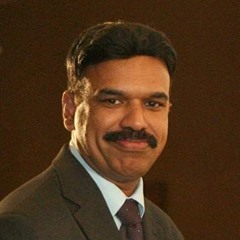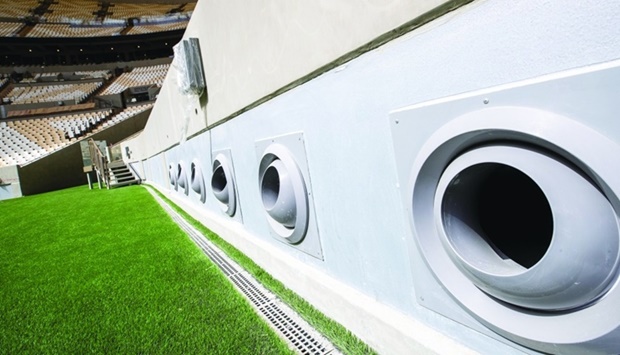The mastermind behind the cooling technologies for the FIFA World Cup Qatar 2022 stadiums, has revealed the details of the whole process.
Nicknamed ‘Dr Cool’, Dr Saud Ghani, professor of mechanical engineering at Qatar University led the Qatar National Research Fund (QNRF) research project resulting in the development of the cooling technologies in the stadiums for the upcoming World Cup.
“Designing air conditioning for an open-air stadium was a big challenge for everyone,” Dr Ghani said. “The biggest design houses in the world had never designed an air-conditioned stadium before, so really, it was left to us. And with sustainability, modularity and functionality in mind, we did it.”
Dr Ghani’s plan was to create and maintain a microclimate bubble within the stadium, a task that inherently becomes harder in open-air stadiums. "The biggest challenge in cooling an open-air stadium is stopping outside warm air from entering it–the defining of the interaction boundary between the inside micro bubble and the outside macro climate. This meant that a detailed aerodynamic analysis needed to be done on the stadium form and footprint to better understand how to use its design to minimise the infiltration of the warm air into the stadium," he explained.
His team began the work by 3D-printing scale models of the proposed stadiums for the World Cup. These models were placed in a wind tunnel for aerodynamic testing to see how their form and size was interacting with the external wind and how it could be improved.
“After the 3D printed model was placed in the wind tunnel, smoke – representing wind – was pushed out at different pressures to test how the design reacted to wind at different speeds and various incoming directions,” continued Dr Ghani. “Then we used laser sheets and cameras to analyse the flow of air over the design, including the manner in which air enters and exits the stadium.”
The measurements were then processed using a Computational Fluid Dynamics software to see what the temperature would be at each tier. Variants such as number of spectators and sweat produced were added, and then numerical simulations were done to see their effect on the temperature distribution inside the stadium.
This step was critical in ensuring that the stadiums’ adaptive aerodynamic design would support the cooling process within the stadium rather than work against it.
Non-technical aspects were also modified with the help of this step. “In Al Bayt Stadium, the initial design featured a darker coloured façade but was later changed to a lighter shade,” said Dr Ghani. “This simple change passively brought down the inside temperature by five degrees Celsius – a quick win.”
Once the designs were optimised, the next step was to start working on the actual cooling system that would create a microclimate inside the stadiums. Dr Ghani’s ‘eureka’ moment in the project was when he realised that he did not need to cool the entire stadium but only the playing field and the spectators.
“We needed to start from the playing field and go up to a height of two metres above the highest spectator seating level. Pumping out huge amounts of cold air to cool the entire open space is inefficient at best. We pump the exact amount of cold air into the exact place, maintain it and contain it—then recycle it all,” he remarked.
Then, he worked on developing a spot cooling system – one which only cooled target areas. After extensive research and testing, the team came up with a state-of-the-art cooling technology that blows cold air on the players via football-sized nozzles alongside the pitch and smaller air diffusers under each spectator’s seat, pushing out cold air at ankle level.
Dr Ghani’s approach is not just innovative, but also sustainable. Using the air circulation technique, the air is then drawn back and re-cooled before being pushed out.
When asked about the need for air conditioning if the tournament is played in winter, Dr Ghani said that it was about thinking long-term and having venues that can be used all year round.
The research effort to cool the stadiums served as a springboard for the pioneering cooling technology which has since been deployed in several places across Qatar, including Katara plaza, a commercial greenhouse, and even for cooling local cow barns.
“The cooling technology used in the FIFA World Cup Qatar 2022 stadiums was not delivered through standards and codes, as is normal practice. Instead, it was delivered by science, which was made possible through QNRF,” added Dr Ghani.
Nicknamed ‘Dr Cool’, Dr Saud Ghani, professor of mechanical engineering at Qatar University led the Qatar National Research Fund (QNRF) research project resulting in the development of the cooling technologies in the stadiums for the upcoming World Cup.
“Designing air conditioning for an open-air stadium was a big challenge for everyone,” Dr Ghani said. “The biggest design houses in the world had never designed an air-conditioned stadium before, so really, it was left to us. And with sustainability, modularity and functionality in mind, we did it.”
 Dr Saud Ghani |
His team began the work by 3D-printing scale models of the proposed stadiums for the World Cup. These models were placed in a wind tunnel for aerodynamic testing to see how their form and size was interacting with the external wind and how it could be improved.
“After the 3D printed model was placed in the wind tunnel, smoke – representing wind – was pushed out at different pressures to test how the design reacted to wind at different speeds and various incoming directions,” continued Dr Ghani. “Then we used laser sheets and cameras to analyse the flow of air over the design, including the manner in which air enters and exits the stadium.”
The measurements were then processed using a Computational Fluid Dynamics software to see what the temperature would be at each tier. Variants such as number of spectators and sweat produced were added, and then numerical simulations were done to see their effect on the temperature distribution inside the stadium.
This step was critical in ensuring that the stadiums’ adaptive aerodynamic design would support the cooling process within the stadium rather than work against it.
Non-technical aspects were also modified with the help of this step. “In Al Bayt Stadium, the initial design featured a darker coloured façade but was later changed to a lighter shade,” said Dr Ghani. “This simple change passively brought down the inside temperature by five degrees Celsius – a quick win.”
Once the designs were optimised, the next step was to start working on the actual cooling system that would create a microclimate inside the stadiums. Dr Ghani’s ‘eureka’ moment in the project was when he realised that he did not need to cool the entire stadium but only the playing field and the spectators.
“We needed to start from the playing field and go up to a height of two metres above the highest spectator seating level. Pumping out huge amounts of cold air to cool the entire open space is inefficient at best. We pump the exact amount of cold air into the exact place, maintain it and contain it—then recycle it all,” he remarked.
Then, he worked on developing a spot cooling system – one which only cooled target areas. After extensive research and testing, the team came up with a state-of-the-art cooling technology that blows cold air on the players via football-sized nozzles alongside the pitch and smaller air diffusers under each spectator’s seat, pushing out cold air at ankle level.
Dr Ghani’s approach is not just innovative, but also sustainable. Using the air circulation technique, the air is then drawn back and re-cooled before being pushed out.
When asked about the need for air conditioning if the tournament is played in winter, Dr Ghani said that it was about thinking long-term and having venues that can be used all year round.
The research effort to cool the stadiums served as a springboard for the pioneering cooling technology which has since been deployed in several places across Qatar, including Katara plaza, a commercial greenhouse, and even for cooling local cow barns.
“The cooling technology used in the FIFA World Cup Qatar 2022 stadiums was not delivered through standards and codes, as is normal practice. Instead, it was delivered by science, which was made possible through QNRF,” added Dr Ghani.




